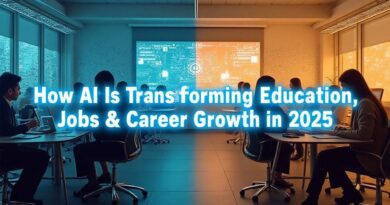AI Image Generators: From DALL·E to Midjourney
AI Image Generators: From DALL·E to Midjourney and Beyond 🎨🤖
AI is no longer just about numbers, automation, or analytics — it’s now an artist, a designer, and a storyteller. Welcome to the era of AI image generators, where machines can create stunning visuals from just a few words. From DALL·E by OpenAI to the mystical landscapes of Midjourney, these tools are revolutionising design, content creation, and even marketing.
In this blog post, we’ll dive deep into what AI image generators are, how they work, where they are used, and why they matter. Whether you’re a student, beginner, or experienced creative, this post will help you understand and leverage AI-generated visuals in real-world applications.
What Are AI Image Generators?
AI image generators are tools powered by machine learning, specifically generative models like GANs (Generative Adversarial Networks) and diffusion models, that can create images based on textual prompts.
Example: If you type, “A futuristic city at sunset, cyberpunk style,” tools like DALL·E or Midjourney will generate detailed, high-resolution images that match your description.
These tools learn from billions of images and text combinations, allowing them to understand visual styles, objects, perspectives, and emotions.
How Do AI Image Generators Work? 🤯
Most modern AI image tools rely on a technique called diffusion modelling, where the AI starts with random noise and gradually transforms it into a meaningful image based on your prompt.
Here’s a simplified step-by-step:
-
Text-to-embedding conversion: Your prompt is converted into numerical values that the model understands.
-
Noise-to-image generation: Starting with a random noise image, the model “denoises” it over many steps.
-
Image refinement: Style, composition, and details are added, often based on training data from artworks, photos, and illustrations.
Popular AI Image Generators in 2025 🚀
Let’s look at some leading platforms in the AI art space:
DALL·E 3 (OpenAI)
-
Platform: Web, integrated into ChatGPT (Pro users)
-
Strengths: Realistic images, artistic flexibility, prompt comprehension
-
Use cases: Marketing visuals, website banners, storytelling, education
-
Example prompt: “A classroom in space with floating desks and a blackboard made of stars”
✅ Real-world use: Teachers use DALL·E to create custom illustrations for complex concepts.
Midjourney
-
Platform: Discord-based (Type commands like
/imagine) -
Strengths: Highly artistic, cinematic quality, abstract creativity
-
Use cases: Album covers, digital posters, fantasy worlds, concept art
-
Example prompt: “A dragon flying through an eclipse, dramatic lighting, fantasy art”
🎨 Artists love Midjourney for its stylised interpretations and creative edge.
Adobe Firefly
-
Platform: Part of Adobe Creative Cloud
-
Strengths: Designed for professionals, supports brand consistency, built on licensed content
-
Use cases: Branding, advertising, professional design workflows
-
Bonus: Generates vector images, patterns, and stylised typography
📊 Adobe Firefly is ideal for marketing agencies and graphic designers.
Leonardo.AI
-
Platform: Web-based
-
Strengths: Game design-focused, concept art, UI design
-
Use cases: Indie game development, app prototypes, character design
-
Community: Growing user base among game devs and illustrators
🎮 Developers are using Leonardo.AI to generate game assets without a full design team.
Bing Image Creator (Powered by DALL·E)
-
Platform: Web (via Bing or Edge browser)
-
Strengths: Free and accessible, powered by DALL·E
-
Use cases: Quick social media content, blog images, visual storytelling
-
Bonus: Integrated with Microsoft tools
📢 Social media managers use Bing Image Creator for daily content calendars.
Key Applications of AI Image Generators 🌍
AI-generated images are used across various industries. Here’s how:
Education
-
Visual aids for lectures
-
Custom diagrams for topics like biology, history, and engineering
-
Flashcards for visual learners
Example: Creating a visual representation of DNA with vivid colours and labels.
Content Creation & Blogging
-
Blog banners
-
Thumbnails
-
Visual storytelling
Example: A finance blog using illustrations of animated coins and robots.
Marketing & Advertising
-
Ad creatives
-
Social media visuals
-
Email banners
Example: AI-generated Valentine’s Day product banners featuring creative themes.
Game & App Development
-
Concept art
-
Game environments
-
UI mockups
Example: Creating an entire sci-fi city for a mobile game level using Midjourney.
Real-Time Example: Designing a Book Cover with AI
Let’s say you’re a student writing a short story or thesis. You want a cover that’s engaging.
Prompt: “A young woman discovering an ancient book in a futuristic library, glowing light, cinematic style”
Use Midjourney or DALL·E, and in under a minute, you have a professional-looking cover — no designer needed!
🖼️ Real-World Applications of AI Image Generators (Expanded)
🎨 1. Creative Design & Concept Art
Use Case: A graphic designer needs to pitch five different styles of a futuristic city skyline to a client.
How AI Helps: Using tools like Midjourney or DALL·E, the designer can input prompts like:
-
“Cyberpunk city skyline at night with neon lights”
-
“Futuristic eco-friendly city with vertical gardens”
Within seconds, the designer gets multiple visuals in various styles. This speeds up ideation and enhances client communication.
🛍️ 2. E-Commerce Product Visualisation
Use Case: A startup wants to display products in various lifestyle settings but lacks a budget for multiple photo shoots.
How AI Helps: Tools like Runway ML and Leonardo AI allow the generation of realistic product images in different backgrounds (e.g., a coffee mug in a modern kitchen, office desk, or outdoor picnic).
This saves both time and cost while offering marketing diversity.
📚 3. Educational Visuals for Students & Teachers
Use Case: A biology teacher wants a visual of the “digestive system of a cow in a cartoon style” for middle school students.
How AI Helps: By describing the image in a prompt, the teacher gets a custom educational illustration tailored to age and comprehension level.
Platforms like Craiyon (DALL·E Mini) are free and effective for such uses in schools.
🎥 4. Video & Film Storyboarding
Use Case: A filmmaker needs concept art for a sci-fi short film but can’t afford a dedicated artist.
How AI Helps: Using Midjourney, they can generate key visual scenes such as:
-
“Alien landscape under two moons”
-
“Futuristic robot marketplace in 2300 AD”
These storyboards guide filming and investor presentations with high-quality visuals.
👗 5. Fashion & Apparel Design
Use Case: A fashion student wants to explore designs like “Indian traditional wear infused with cyberpunk elements.”
How AI Helps: Using DALL·E 3 or Stable Diffusion, they can iterate designs, tweak colours, and visualise wearable art concepts before physical production.
This supports creative exploration without material cost.
📖 6. Book Illustrations & Cover Art
Use Case: A self-published author writing a fantasy novel needs cover art with “a warrior princess riding a phoenix at sunset.”
How AI Helps: Tools like Dream by Wombo generate stunning illustrations for covers, chapter art, or promotional banners.
This makes self-publishing more accessible than ever.
🧠 7. Therapy & Mental Wellness
Use Case: A counsellor uses images to help patients visualise emotions or inner landscapes.
How AI Helps: Prompts like “a calm mind represented by floating clouds over still water” help in emotional processing through metaphorical images.
It’s being used in art therapy sessions to encourage creative self-expression.
🧪 8. Scientific Visualization
Use Case: A researcher needs to visualise “an atom with quantum entanglement and abstract energy flows.”
How AI Helps: AI can create metaphorical, artistic representations that help explain complex theories visually to non-experts or in presentations.
🧑🎓 Additional Real-Time Example: Students Creating Resume Portfolios
Use Case: A student applying for creative roles needs a standout visual resume or portfolio website.
How AI Helps:
-
Use DALL·E 3 to generate a personalised character portrait.
-
Add images that match project themes (e.g., “UI design for mobile app for senior citizens”).
-
Create thematic visuals to brand their portfolio consistently.
It creates a professional look without hiring designers.
🔄 Emerging Integration in Apps & Tools
-
Canva AI now integrates text-to-image for quick visuals.
-
Microsoft Designer uses AI art generation for marketing assets.
-
Figma plugins are integrating with Stable Diffusion for design mockups.
🌍 AI in Social Media Content Creation
Example: A YouTube content creator generates thumbnails using:
-
“Excited man looking at flying AI robot in a futuristic lab” – eye-catching and unique thumbnails.
-
Custom background images that align with each video topic.
It enhances engagement, click-through rate (CTR), and branding.
🔒 Ethical & Copyright Considerations
While AI image generators are incredibly useful, users must:
-
Be aware of copyright (generated images might not be commercially safe unless licensed).
-
Avoid prompt mimicry of specific artists unless allowed.
-
Give attribution when required (depending on platform usage).
Example: Commercial use from Midjourney is allowed under their paid plan. OpenAI’s DALL·E requires checking their terms for each case.
💡 Tips for Beginners: Getting the Best Out of AI Image Generators
-
Be Specific: Add styles, colours, objects, lighting, and moods to your prompt.
-
Example: “Vintage style poster of a spaceship landing in a cornfield during sunset in watercolour style.”
-
-
Use Prompt Builders: Some platforms provide dropdowns or prompt wizards to make suggestions.
-
Iterate Rapidly: Slight changes like “cyberpunk” vs “futuristic” yield drastically different images.
-
Compare Results: Use the same prompt across tools (e.g., DALL·E vs Midjourney vs Leonardo AI) to evaluate quality and fit.
Ethical Concerns & Limitations 🛑
While AI image generation is powerful, it’s not without limitations:
-
Bias: AI models may reflect societal or cultural biases.
-
Plagiarism: Some argue it borrows heavily from existing art.
-
Job impact: Designers fear job displacement.
Tip: Always disclose if an image is AI-generated, especially in academic or journalistic work.
Tips for Writing Effective Prompts 🧠
-
Be specific: “A cat in a suit” is vague; try “A realistic tabby cat wearing a grey business suit, sitting at an office desk”
-
Add style: “in Pixar style,” “cyberpunk,” “minimalist”
-
Use emotions: “peaceful forest,” “dramatic sky,” “chaotic battle scene”
💡 Prompt engineering is an emerging skill — practice makes perfect!
How to Get Started with AI Image Tools
-
Create accounts on platforms like Midjourney, Leonardo.AI, or OpenAI.
-
Practice prompts using different genres and themes.
-
Join communities: Reddit, Discord servers, and forums offer feedback and support.
-
Use for projects: Add AI images to school projects, resumes, websites, or presentations.
The Future of AI Image Generation 🔮
Expect to see:
-
More control over elements (object placement, style, lighting)
-
Video generation from prompts (already started!)
-
Real-time 3D modelling for games
-
Integration into platforms like Canva, Figma, or MS PowerPoint
AI images are going beyond creativity — they’re shaping workflows across education, business, design, and tech.
Final Thoughts: Why You Should Learn AI Image Generation Today
AI image tools are no longer niche — they’re mainstream, easy to use, and endlessly useful.
- Students can enhance presentations.
- Freshers can build personal brands.
- Creators can launch projects without expensive designers.
With just a few words, you can bring imagination to life. Start exploring — your creativity just found a new best friend in AI.
📤 Stay Updated with NextGen Careers Hub
📱 Follow us on Instagram
📺 Subscribe to us on YouTube
Please share our website with others: NextGenCareersHub.in






Comments are closed.